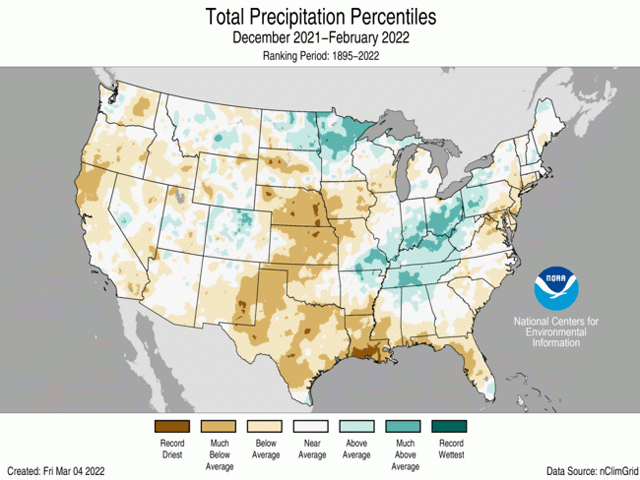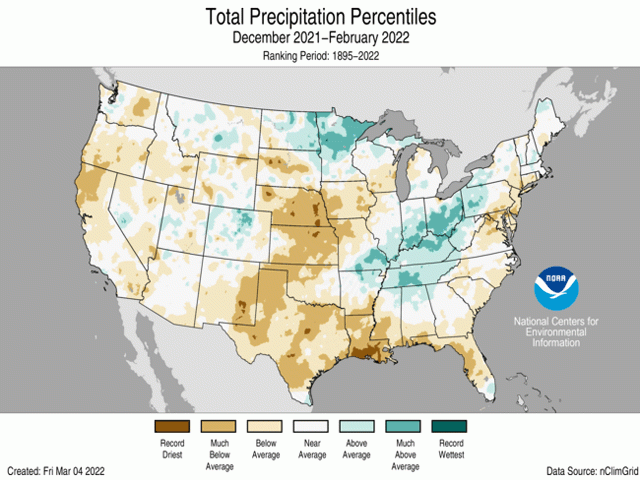Ag Weather Forum
Winter Precipitation Review Shows Record Dryness in Some Areas
Meteorological winter 2021-22 did not change how moisture was allocated going back to last fall. A focus of moisture on the far northern and the southeastern Midwest continued. Meanwhile, soils in the western and northeastern Midwest and the central through southern Plains, along with the Deep South, had either well-below-normal amounts or were record dry.
The meteorological winter covers the months of December, January and February. The NOAA National Centers for Environmental Information (NCEI) summary of precipitation details that difference:
"Precipitation was above average across parts of the Upper Mississippi, Ohio, and Tennessee valleys. Minnesota had its 10th-wettest winter. Precipitation was below average across portions of the West, central and Southern Plains, Gulf Coast and across parts of the Southeast and Mid-Atlantic. Louisiana had its third-driest winter on record with Nebraska ranking fourth driest and Kansas, fifth driest."
The drier areas have, of course, low soil moisture and deteriorating winter wheat conditions as noted in the March 9 USDA weekly weather and crop bulletin. "By Feb. 27, topsoil moisture was rated 75 to 80% very short to short in Kansas, Oklahoma, and Texas, according to USDA/NASS. On that date, winter wheat was rated 75% very poor to poor in Texas, along with 65% in Oklahoma and 38% in Kansas. Texas also reported 69% of its rangeland, pastures, and oats were rated in very poor to poor condition. During February, short-term dryness notably worsened across much of Nebraska, extending into Iowa and northwestern Missouri, as well as portions of neighboring states."
P[L1] D[0x0] M[300x250] OOP[F] ADUNIT[] T[]
Areas that took in above-normal precipitation during the December-February winter season now have some borderline wet soils ahead of spring fieldwork. USDA/NASS reports show that as of late February, topsoil
moisture rated 60% surplus in Indiana; 55% surplus in Ohio; 52% surplus in Michigan; and 40% surplus in Illinois. And in the far northern Midwest, drought has been completely eradicated in western Minnesota and the eastern Dakotas.
However, drought is still a dominant feature. Drought expanded by 4 percentage points during February to now cover 59.2% of the lower 48 states. Summaries from the USDA/World Ag Outlook Board note that national drought coverage was last greater more than 9 years ago, on Jan. 8, 2013. National drought coverage has exceeded 40% for a record 75 consecutive weeks in the U.S. Drought Monitor era, extending from Sept. 29, 2020 to March 1, 2022.
And in the western U.S., the conditions continue to be historically dry.
Research meteorologist Daniel Swain at the National Centers for Atmospheric Research in Boulder, Colorado writes that "Jan-Feb 2022 period was driest on record (in at least 127 years) across nearly all of northern and central California, as well as much of northern Nevada and NW Utah." Other areas in the West were drier than average except for record wet conditions along the Front Range of the Rocky Mountains in Colorado (again--either nothing or a great deal when it comes to precipitation).
The NOAA/NCEI winter precipitation report has a daunting forecast comment in conclusion for the western U.S. "Climatologically speaking, winter is the wet season across much of the western U.S. If the dry conditions experienced in January and February across portions of the West were to continue into March and April, insufficient water resources may result during the dry season (summer), as well as an increased potential for drought intensification and wildfires in the fall."
Bryce Anderson can be reached at Bryce.anderson@dtn.com
Follow him on Twitter @BAndersonDTN
(c) Copyright 2022 DTN, LLC. All rights reserved.






Comments
To comment, please Log In or Join our Community .